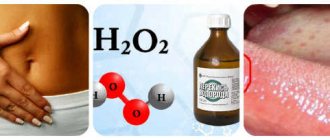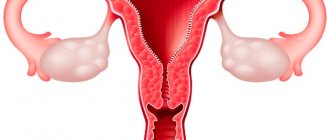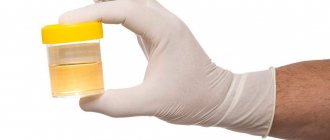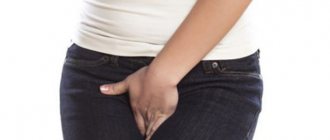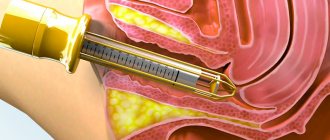Professor Neumyvakin I.P. recommends using hydrogen peroxide against gynecological diseases such as thrush (or candidiasis).
One of the most effective methods is douching with hydrogen peroxide, which can be done at home. Irrigation of the vagina with a peroxide solution is a way to cleanse the internal genital organs of the small pelvis from pathogenic microorganisms. Any gynecological diseases bring inconvenience and disrupt the usual way of life. But in order to correctly implement treatment at home with peroxide, you need to know when this or that method is used and how to carry out the procedure. Douching based on H2O2 helps women cope with various sexual ailments. Depending on the pathogen, tablets, suppositories, and special ointments are prescribed for the traditional treatment of female diseases. If specific cases arise, gynecologists often recommend alternative methods to patients, for example, douching with 3% hydrogen peroxide. This method allows for vaginal sanitation in case of inflammation of the female genital organs, infections, pathological discharge and other problems.
How does hydrogen peroxide affect the vaginal microflora?
Hydrogen peroxide is a natural substance. It is present in every organism, supporting all processes of bioorganic metabolism. In addition, it is involved in the functioning of the enzyme and endocrine systems. Promotes the penetration of sugar from plasma into cells without the help of insulin.
Hydrogen peroxide also has a detoxifying function. This means that this substance oxidizes dangerous toxins, bacteria and stops viruses. Moreover, under the influence of the enzyme, catalase is converted into atomic oxygen and water and protects tissues from damage.
Another property of hydrogen peroxide is its anti-aging effect. Active oxygen supports skin regeneration, and also accelerates blood circulation and strengthens blood vessels. Such properties of peroxide contained in cosmetics are very useful for sensitive skin, with a tendency to form a network of capillaries and ulcers.
Hydrogen peroxide is an unstable compound. Decomposes with the release of atomic oxygen due to catalase contained in tissues. This reaction occurs rapidly in the presence of necrosis and necrotic tissue.
The released oxygen has a bactericidal effect, whitens, cleans mechanically dried, bruised wounds, and softens scabs. A 3% solution stimulates granulation.
Attention! When it comes into contact with the vaginal microflora, hydrogen peroxide oxidizes organic molecules, which means it affects not only pathological microorganisms, but also beneficial bacteria. Therefore, the use of hydrogen peroxide in gynecology should be justified.
But if the benefits of douching with peroxide solution are greater than the possible harm, women often resort to douching with peroxide. This is a quick, effective way to get rid of pathogenic microbes, clean and dry wounds, remove mucus and pus.
Read the useful article “Douching with soda as a way to combat female diseases”
Possible side effects
The following side effects may occur during the procedure:
- burning;
- swelling;
- itching;
- heavy discharge;
- painful sensations.
If such symptoms appear, stop treatment and seek medical help.
Douching eliminates both pathogenic microorganisms and healthy microflora, which negatively affects the woman’s condition. The absence of beneficial bacteria creates conditions for the occurrence of vaginal dysbiosis and the penetration of infections. Therefore, doctors do not recommend abusing this treatment method.
Recipes for douching solutions and tampons
For treatment, you must first prepare a 1-2% solution of mumiyo (buy at a pharmacy). Then add to 200 ml of the resulting solution:
- 1 day - 10 drops of 3% hydrogen peroxide;
- Day 2 - 15 drops;
- Day 3 - 20 drops.
- Days 4 and 5 - 20 drops.
This solution can be used as a microenema in the rectum after cleansing the intestines for inflammatory diseases of the appendages; for douching and tampons for problems associated with pathological processes in the vagina and cervix.
The course of treatment is 5 days, 2 days break. You can do up to 5 such courses. During the break at night, put tampons with aloe juice or sea buckthorn oil. Peroxide is very drying, so it is better to use tampons that nourish the epithelium at night on break days.
“There has never been a universal treatment for everyone... except for hydrogen peroxide.” I. Neumyvakin.
Another recipe that doctors often recommend: 1 teaspoon of 3% peroxide per glass of water. This mixture is more aggressive; when applied, it causes a tingling sensation that quickly passes. Do not use for more than 3 days, otherwise it dries out the mucous membrane very much.
Contraindications
Irrigation of the vagina with peroxide against gynecological diseases at home is due to a number of contraindications. Thus, it is strictly forbidden to use hydrogen peroxide to treat the genital internal organs of women if they have the following diseases and pathological conditions:
- hypersensitivity to the drug;
- advanced cervical erosion;
- ulcers of the vaginal mucosa;
- acute inflammatory processes;
- menstruation;
- cancer of the vulva, cervix stages 3 and 4;
- after an abortion;
- postpartum period - at least 40 days after birth.
It is especially worth noting douching during pregnancy - during this period the use of the method is unacceptable! When a woman is pregnant, irrigation with hydrogen peroxide is not possible for the following reasons:
- risk of air passing through the cervix;
- if it gets into the fetus, peroxide can adversely affect its development;
- damage to the amniotic sac.
In addition, the risk of premature birth increases. Therefore, scientist Neumyvakin is extremely categorical in observing the recipe and indications for the use of H2O2 by women for medicinal purposes. Despite a lot of positive qualities, not taking into account contraindications - douching with 3% hydrogen peroxide can cause irreparable harm to the vaginal microflora, which in turn can provoke serious consequences.
How to prepare and use hydrogen peroxide solution for douching
You should use diluted hydrogen peroxide immediately after preparation, since the solution quickly loses its properties when exposed to light.
The water must be boiled, the temperature is 37-38 degrees.
Before preparing the working solution, the dishes must be thoroughly washed and doused with boiling water; the syringe must be washed with soapy water and rinsed with boiling water each time before and after use.
Before inserting the douche, the entrance to the vagina must be lubricated with any intimate cream, Vaseline, pharmaceutical glycerin, lanolin.
It is best to perform the procedure while lying on your back with your knees bent.
The tip of the syringe is inserted to a depth of no more than 7 cm. The liquid is released as slowly as possible.
Attention! It is strictly unacceptable to douche with a pure 3% peroxide solution directly from the bottle. Inflamed and sensitive mucous membranes can get burned from direct exposure to perhydrol.
After successful treatment, a course of lactobacilli is recommended. Doctors recommend the drugs Acylact, Lactonorm, Lactozhinal.
To do this, you can use any pharmaceutical drug containing strains of lactobacilli: acylact, lactonorm, lactoginal, etc. Oral drugs, such as Vagilak or Narine in capsules, are also perfect.
Precautionary measures
Using peroxide for thrush requires compliance not only with the rules for diluting the solution, but also with caution. Before douching, you should familiarize yourself with the basic safety recommendations for using peroxide. During therapy, the following rules should be observed:
- The syringe used must be new and disinfected before use;
- The solution is prepared fresh each time immediately before douching;
- Water for mixing should be boiled and cooled;
- The genitals should be washed with water before douching;
- The solution is introduced into the vagina gradually;
- The procedure should not take more than 15 minutes.
The syringe used must be new. The solution is prepared fresh every time. Boiled water. You should wash before syringing.
You should always use a freshly prepared solution. Hydrogen peroxide loses its healing properties under the influence of light. In order to correctly maintain the proportions for diluting the composition, always prepare it per 1 liter of water, even if you use a much smaller volume for douching. A possible burn to the already irritated mucous membrane will cause much more health problems.
A sharp injection of peroxide into the vagina can cause vasospasm, so you must be careful when working with a douche. Such treatment should be stopped when signs of candidiasis disappear. Uncontrolled administration of the drug irritates the microflora of the vaginal environment, so douching “in vain” will not bring any health benefits.
If the procedure causes discomfort or tingling when diluted peroxide is administered, the procedure should be interrupted and consult a doctor. You may have diluted the solution incorrectly or administered it internally.
Douching with peroxide for thrush
One of the effective ways to treat thrush is douching. With this disease, douching attacks fungi and perfectly removes infected secretions.
For this procedure, herbal decoctions or chemical solutions are used. Douching with hydrogen peroxide is a fairly common method of treating thrush. Hydrogen peroxide promotes the production of bacteria in the vagina that control the proliferation of fungal microorganisms.
If the vaginal microflora is disturbed and beneficial bacteria cannot cope with the rapid proliferation of fungi, then douching procedures with hydrogen peroxide will help. After the clinical symptoms of thrush disappear, douching should be stopped, since abuse of this method can disrupt the microflora and lead to inflammation.
Using hydrogen peroxide in gynecology, you can solve many problems with a simple, cheap remedy. But don't get too carried away. Follow the recipes and instructions and may your health be in order.
Reviews
Oksana Vasilyeva, 24 years old. Gardnerellosis was diagnosed in the initial stage of development, and the local gynecologist advised douching with hydrogen peroxide. Of course, I doubted her competence, although she is a doctor with extensive experience and work experience in gynecology. I decided to go to a private paid clinic - the result of the disease was the same. But when I asked a question about peroxide, I was, of course, surprised by the answer. Yes, this is quite acceptable, moreover, this method was also used by our grandmothers, because... Hydrogen peroxide has always been and remains the cheapest and most effective drug against viruses and infections, including female diseases. However, I did not calm down and started looking for information on the Internet, and then I was truly amazed at how many sites and blogs were dedicated to this technique. I went to one forum and contacted women online who had already tried this type of treatment - their answers suited me quite well. After 4 days of douching procedures, improvements were obvious. By the way, the discharge with an unpleasant odor disappeared on the second day. After the full course (10 days), the disease disappeared completely!
Evgenia Podkopaeva, 32 years old. I defeated candidiasis at home with the help of hydrogen peroxide. It's already been six months since the last relapse. I’ve tried so many things, so many nerves - my periods pass, thrush comes, and so on for 3 years. The gynecologist prescribed more and more antibiotics, but no results. Finally, during one of my visits to the antenatal clinic, one woman in line advised me to try douching and washing with hydrogen peroxide. At home I read reviews from various forums about the Neumyvakin system and decided to try it. As I said at the beginning, candidiasis has not bothered me at all for six months now, and all thanks to hydrogen peroxide.
Fighting thrush with a solution
Candida fungus is the cause of thrush in women. You can get rid of this disease once and for all by carrying out a comprehensive and effective treatment once. A peroxide solution allows you, if not to completely get rid of the very cause of the disease, then at least to protect yourself from relapses.
This technique involves sanitizing the vagina, which has an antiseptic and antibacterial effect. It is advisable to carry out therapy at home every day throughout the entire treatment course. The main advantage of this approach is that perhydrol practically does not cause side effects, its chemical formula allows you to stop the development of the fungus, and its methodical effect completely neutralizes pathogenic organisms.
To prepare a solution for vaginal douching, you need to take a 3% solution of hydrogen peroxide and dilute it with warm boiled water (37-38 degrees Celsius): 3 parts water to 1 part disinfectant. Or prepare a solution with an even weaker concentration: add 2 tablespoons of a 3% hydrogen peroxide solution to a liter of boiled water. You need to use diluted hydrogen peroxide as quickly as possible, because... under the influence of light it begins to lose its properties.
Below are examples of the most popular and effective solutions that can be used to douche for thrush at home.
Soda is the simplest, most accessible, safe and cheapest remedy than douching for thrush; it is always available at home and shows excellent results. Soda is good because it creates an alkaline solution, but it is detrimental to thrush fungus.
Dilute ½ teaspoon of soda in 1 glass of boiled water. After administering the solution, you need to lie down for at least 1 minute. Douching is carried out 2-3 times a day for a week.
Excessive and prolonged administration of soda can inhibit the beneficial microflora of the vagina and cause inflammation. You can read more about how to treat thrush with baking soda here.
Chlorhexidine
Chlorhexidine is a powerful antiseptic that acts on many types of microorganisms, including fungi, due to the content of chlorine ions. The solution is sold in pharmacies in finished form. It should be stored in a dark place, used at room temperature, and should not be heated.
Douching with Chlorhexidine for thrush is done 1-2 times a day for 4-5 days. Caution should be exercised if you are allergic to chlorine-containing products.
If itching and irritation appear after the first douching, you should stop using it and consult a doctor.
In order not to experience inconvenience with douching, the solution can be successfully replaced with vaginal suppositories with chlorhexidine, used once a day at night.
Furacilin
Furacilin solution is sold in pharmacies ready-made in bottles. This antiseptic is active against bacteria, but the fungus is resistant to it. Therefore, it is impossible to cure thrush only by douching with furatsilin.
Furacilin solution is used for periodic douching to relieve associated inflammation, itching, and burning.
Long-term use is not recommended due to the risk of developing bacterial candidiasis.
Chamomile
Chamomile flowers contain a natural antiseptic and bioactive substances that stimulate tissue repair.
Prepare chamomile infusion as follows:
- Brew 3-4 teaspoons of dried flowers in 1 liter of boiling water.
- Leave for 1 hour, filter.
- Douching can be done 5-6 times a day for 7-10 days without fear of consequences.
Chamomile infusion has a gentle effect, does not dry out the mucous membrane, reduces itching and irritation well, and has deodorizing properties.
Tea tree oil
This product is widely used due to its strongly expressed antiseptic, antiparasitic and antifungal effects, therefore it is used in very low concentrations.
The solution is prepared as follows: the oil is mixed with medical alcohol in equal quantities in advance, and this mixture is stored in the refrigerator.
For douching, add 4-5 drops of solution to 1 glass of warm boiled water and shake well. The procedure is carried out once a day at night for 6-7 days.
Onion and St. John's wort
An excellent combination of 2 natural components: onion with its phytoncides and St. John's wort, known for its antiseptic and wound-healing effects. First, prepare a decoction of St. John's wort: 4 teaspoons of dry herb, brew 1 liter of boiling water, leave on low heat or in a water bath for half an hour, cool.
To 1 glass of broth, immediately before douching, add 1 teaspoon of freshly squeezed onion juice (grate the onion, squeeze the mixture through cheesecloth). The number of douches is 3-4 times a day for a week.
Sage has a fungicidal effect, raspberry leaf is a powerful stimulator of tissue immunity and wound healing.
You need to prepare a dry collection in advance, consisting of equal parts of raspberry leaves and sage herb. To prepare the solution, brew 3 tablespoons of the mixture per 1 liter of boiling water and leave on low heat for 10-15 minutes. When the broth has cooled, it is filtered.
Douching is done every other day for 2 weeks, and if the symptoms of candidiasis are pronounced, then the procedure should be daily.
Acidic solution
Solutions of acids are also well suited for douching: lactic, acetic, citric, boric. They increase the acidity of the vagina and create unfavorable conditions for the development of fungus.
A solution of lactic or boric acid is prepared at the rate of: 1 teaspoon per 1 liter of warm boiled water. Table vinegar 6-9%, preferably apple cider vinegar, diluted in the proportion of 1 teaspoon per glass of water, freshly squeezed lemon juice is also prepared.
The number of douchings is 2-3 times a day, no more than a week.
An increased concentration of acid can damage the mucous membrane, so it is recommended to combine the use of acids with other remedies: chamomile, St. John's wort.
Hydrogen peroxide
Douching with hydrogen peroxide for thrush has a double effect: it cleanses the vaginal mucosa well of fungal plaque, washes out secretions from the cavity, and the oxygen released with the foam has a detrimental effect on the fungus.
A pharmaceutical 3% peroxide solution is diluted with warm boiled water at the rate of 1 teaspoon per 200 ml. water.
The number of douchings is 4-5 times a day until complete recovery, until the liquid flowing out during douching stops foaming.
Calendula
Calendula has an antifungal effect and stimulates the restoration of the mucous membrane, and is very effective against candidiasis.
Prepare a fresh infusion: pour 1 teaspoon of dried flowers with 1 glass of boiling water, leave for 1 hour, filter.
Douching with calendula for thrush can be done frequently - up to 6 times a day, without fear of any side effects on the mucous membrane. The effect occurs quickly, the duration of treatment is until recovery.
Manganese
Douching with potassium permanganate for thrush is an old, proven remedy for treating various types of vaginitis, including candidiasis. The active substance is the released oxygen.
Potassium permanganate powder is dissolved in water until it turns pink (not dark).
Care should be taken not to get crystals on the mucous membrane, as they can cause a burn.
To avoid burns, you need to prepare a concentrated solution in advance and store it in a tightly closed bottle. Add to warm water for douching drop by drop until a pink color is obtained. You can douche 3-4 times a day until the discharge stops.
Borax in glycerin
This mixture is sold in pharmacies in finished form. Effective in unadvanced cases of candidiasis. Glycerin has adhesive properties, so before douching you should first clean the vagina with a solution of potassium permanganate.
The number of douches begins with 3-4 times a day on the first day (loading dose), from the 2nd day - 1 time a day at night. The duration of treatment is 1 week.
If the borax and glycerin mixture is stored in the refrigerator, it should be taken out in advance and kept at room temperature so that it is not cold.
Methods of carrying out the procedure
During the procedure, syringes equipped with a soft tip are used. This will prevent damage to the vaginal walls and further infection.
The syringe must be sterile, so it should be cleaned before use.
For douching you will need a 1% peroxide solution, which is obtained by diluting the following components:
- warm water (boiled) – 300 ml;
- 3% hydrogen peroxide - 100 ml.
- The syringe is treated with a disinfection solution. Boiling is used as an alternative method.
- To administer the solution, lie on your back and spread your legs.
- The tip of the device is treated with Vaseline.
- If the procedure is carried out on a bed, then select a container in advance into which the solution is poured.
- The drug is administered no deeper than 7 cm. Hydrogen peroxide is pushed out by muscle effort.
The duration of the manipulation is 10–15 minutes. At the initial stage of treatment, douching is carried out 2 times a day, after that - 1 time a day. When improvements appear, therapy is carried out every other day, gradually reducing the number of procedures to 1-2 per week.
The duration of the course is no more than 1 week, but the doctor may prescribe other dates
As a solution for douching, many women can use various decoctions of medicinal herbs, but as practice shows, recently cases of excessive douching with ordinary hydrogen peroxide have become more frequent.
At the same time, everything comes to the point that douching with hydrogen peroxide causes even greater harm to women's health. And all this happens due to the fact that the female sex simply abuses this procedure.
Many people know that in a woman’s vagina there is a so-called protective environment in which mucus is secreted. Thanks to this mucus, excess elements are removed from the vagina. In the normal environment of the female vagina there are lactobacilli, which provide an acidic environment where microorganisms cannot multiply.
As soon as changes begin, women immediately experience so-called vaginal dysbiosis. And the development of this condition is a direct source of various infections and the development of colpitis.
If, in the treatment of inflammatory processes, in addition to medications, you use a syringe with hydrogen peroxide, then the normal microflora of the vagina returns to normal quite quickly due to the restoration of the normal number of bifidobacteria and lactobacilli.
There is nothing complicated about this process. The main thing is to correctly remember the sequence of necessary actions and all the conditions.
First of all, you need to remember that only boiled, not running water should be used for vaginal douching. Ideally, the water temperature should be around 37°C - 38°C, but not very hot.
After the warm water has been prepared, you need to proceed to preparing the peroxide. To do this, take approximately 100 ml of 3% peroxide and mix it with 300 ml of warm water. You can also prepare a solution with a slightly weaker concentration. For such a solution, only a few tablespoons of peroxide are needed per 1 liter of warm water.
After the solution is ready, you can proceed to douching. This procedure is best performed either in the bathroom or on the sofa in a lying position. You need to take a syringe and pour the solution into it.
A small tip should be inserted onto the edge of the vagina. As soon as you press the douche, the liquid will immediately flow into the vagina. This procedure must be carried out for 10-15 minutes.
What do you need to remember?
- Hydrogen peroxide is an antiseptic-antioxidant, which is not one of the main drugs against thrush in women.
- Traditional medicine does not recognize peroxide as a medicine for the treatment of vaginal candidiasis; there is no such indication in the official instructions.
- In gynecological practice it is used for disinfection, but the drug does not have antifungal activity.
- If a woman nevertheless decides to undergo medical procedures, peroxide is used to douche the vagina and wash the external genitalia.
- It is important to remember the potential harm of this method of therapy and not to use it without prior consultation with your doctor.
Literature:
- Axramov D, M. Kuzma L. A-g Sukolin G-I. Treatment of vulvovaginal candidiasis. U News, dermatology and venereology. 1993, - No. 2. -WITH. P.
- P. Bayramova G. R. Vulvovaginal candidiasis. Rational pharmacotherapy. // Gynecology. Extraissue, 2006. P, 7-10.
- Kashkin P.N., Lisin V.V. Practical guide to medical mycology. Leningrad: Medicine; 1983.
- Kagramanova Zh A, Machnovskaya V V. / Complex therapy of chronic recurrent vulvovaginitis. Materials of the VII t Russian Forum “Mother and Child”. M., 2006 pp. 399-400.
- Kasabulatova N-M- / Vaginal candidiasis Ch breast cancer 2003. - T. II. - L 17. - P. 985-989.
- Burova S.A. Treatment of recurrent candidal vulvovaginitis // Modern mycology in Russia: abstract. report I Congress of Mycologists.
- Baranov I.I. Ecology of the vagina and inflammatory diseases of the genital organs // Gynecology. - 2010. - T. 12., No. 3. — P. 4 — 6.
- Sergeev Yu.V. Pharmacotherapy of mycoses / Yu.V. Sergeev, B.I. Spiegel, A.Yu. Sergeev. — M.: Medicine for everyone. - 2003. - 200 C.
- Candida albicans and bacterial vaginosis can coexist on Pap smears / Q. Wei // Acta Cytol. - 2012. - Vol.56, N 5. - P. 515 - 519.
| Miramistin | Miramistin |
| 5–7 days | ||
| Citeal |
|
| determined individually | ||
| Herbal decoctions | dry vegetable raw materials | anti-inflammatory components contained in chamomile flowers, calendula, sage leaves, oak bark, etc. |
| Can be used in pediatrics | 10–14 days |
| Hexicon |
| chlorhexidine bigluconate |
| not used to treat children under 12 years of age | 7–10 days |
Mechanism of action
Hydrogen peroxide is an antiseptic-antioxidant intended for local, external treatment of affected areas of the body. The drug only temporarily reduces the number of pathogenic and opportunistic microorganisms without exhibiting a pronounced sterilizing effect.
Upon contact with affected areas of the skin and mucous membranes, oxygen is actively released, which mechanically cleanses and neutralizes organic substances
If a woman intends to treat vaginal candidiasis with peroxide, the following important points must be taken into account:
- gynecologists note that hydrogen peroxide is not the drug of choice for the treatment of vaginal candidiasis;
- the drug cleans wound surfaces from residual biological material, reduces bleeding, but does not have an antifungal effect;
- Regular use of the medicine is fraught with irritation of the vaginal mucosa, disruption of the natural microflora, and the addition of secondary infections.
It is important to remember that hydrogen peroxide is unstable in an alkaline environment when interacting with metals, antioxidants, and radicals. Loses its healing properties when exposed to direct sunlight and in a warm room for a long time.
Use of perhydrol for gardnerellosis
Often, if such a disease is detected, it is necessary to immediately consult a doctor. But it happens that medical prescriptions may not bring the desired result. In this case, douching with peroxide can be effective.
Remember that lactobacilli, when interacting with hydrogen, form an acidic environment, which is favorable for them. But when they die, an alkaline environment arises, which stimulates the development of gardnerellosis. Douching is necessary in the same way as for thrush.
Remember that at the beginning of any treatment, you must seek advice from a specialist or your doctor. The main thing is not to harm your body.
Health to you!
